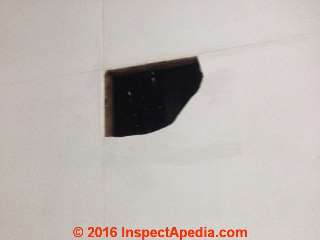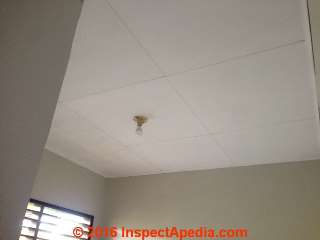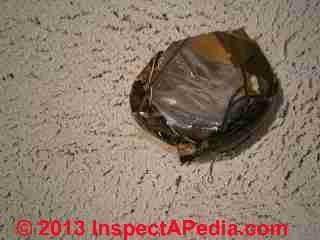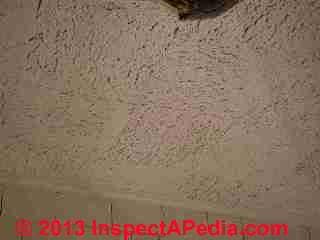 Asbestos-Suspect Acoustic Ceiling Tiles Cover-Up
Asbestos-Suspect Acoustic Ceiling Tiles Cover-Up
- POST a QUESTION or COMMENT about how to identify ceiling tiles that contain asbestos
Asbestos-suspect ceiling cover-up:
What is the best way to reduce the hazard from an asbestos-containing ceiling that is shedding or that is in poor condition. We describe laminating gypsum board over an asbestos-suspect ceiling in Indonesia.
Separately, A reader describes a simple, inexpensive, but labor intensive approach to coating or cover-over of asbestos-suspect ceiling tiles or panels that are securely fastened and in good condition.
Covering asbestos or asbestos suspect materials in some locations is permitted and makes economic sense as a method of reducing the asbestos hazard in buildings. In fact generally it's better, cheaper, and safer to leave non-friable, un-damaged asbestos materials in place than to try a demolition and removal project.
InspectAPedia tolerates no conflicts of interest. We have no relationship with advertisers, products, or services discussed at this website.
- Daniel Friedman, Publisher/Editor/Author - See WHO ARE WE?
Do-It-Yourself in-Place Seal-Over for Asbestos-Suspect Acoustic Ceiling Tiles
 Reader Question: we suspect that this ceiling in our Indonesian home contains asbestos and pieces of it are falling.
Reader Question: we suspect that this ceiling in our Indonesian home contains asbestos and pieces of it are falling.
How can we reduce the asbestos-exposure risk for our family living in Indonesia
[Click to enlarge any image]
We are Americans, but our family lives and runs a non-profit on a small island in east Indonesia. About a year ago we moved into a new house. After moving in we heard one of the locals use the term asbes to describe our ceiling.
We later learned through a friend that was able to get a bit of our ceiling tile tested that it contains high levels of asbestos.
We know another ex pat family that ripped all the asbestos out of their house here, but the workers used no safety precautions at all.
Our ceiling has been in good shape and all the research we showed said ripping it out would do way more damage than just leaving it.
Yesterday morning the kids and I were playing out in the living room and a 1 ft x 1 ft piece of the ceiling tile dropped just a few feet from us. We got the kids out and my husband quickly cleaned it up.
Unfortunately he forgot to dampen it first...but swept it up and then wet mopped. I was hoping you could give us some advice on cleaning things up. We have no access to special vacuums or people that can come do assessments on air quality.
Thankfully our floors are all tile and it is wet mopped daily. We do have one AC in the house, but everything else is cooled by fans.
How would we go about cleaning the AC? And are the fans helpful un getting the air out or are we just re circulating dust? We wiped down everything with a damp cloth and laundered all linens, but will the dust seep into mattresses, pillows, stuffed animals, etc. that the kids interact with daily?
We love being here and what we do, but I struggle with putting the kids health at risk and how we can protect them.
Most online resources are for countries that have agencies that deal with this, and unfortunately that is just not available on our island. Any help you could offer in the best way to clean would be greatly appreciated!
As we look to the future...it was a cat that caused this issue, and we have no way of ensuring it doesn't happen again...my husband is looking to put in a second ceiling just below the asbestos ceiling with wood supports in areas that look concerning.
What are your thoughts on that in regards to limiting exposure in the future?
Again, thank you so much for what you do to help others and taking the time to read this email! Any thoughts you have would be welcomed & appreciated! - private email, M.S. to editor 2016/04/04
Reply: how to laminate a thin veneer of gypsum board or drywall over an asbestos-suspect ceiling
We need to understand the structure of the existing ceiling, but I suspect it would be easy to simply laminate onto the existing surface a layer of thin gypsum board or drywall. If you disturb the existing ceiling as little as possible as you know leaving it in place as the lowest risk.
Reader follow-up: ceiling materials were confirmed as containing asbestos
The house was built in 1990 and I presume the ceiling is original to the construction. The kitchen and bathroom were added on later and have a different ceiling material. We did have a sample sent back to be tested in the States and have confirmed the material contains asbestos.
By laminating, do you mean to just install gypsum board over the existing ceiling and try to drive the screws in the existing gap into the wood?
I am sure there may be some seems where we will get into the asbestos product because of the width of the gap is not wide enough to match 2 edges of gypsum board.
We don't have much gypsum board here in Indonesia, would plywood work the same? I will do some research on thin gypsum board and see what I can find.
Do you have any suggestions on minimizing dust and what we need to do with our stuff while the ceiling in the room is being installed... i.e. , do we move everything (porous material that would collect the dust) out then put it back after construction?
One nice thing is that the floors are tile throughout the house. I read that mopping helps clear fibers faster. Is that true?
Thanks again for taking the time to answer these questions. It is night here, but if it would help I can take a photo of the hole with a proper camera (not my cell phone) and send it your way.
...
I am including a few pictures with this email to give you a better sense of of our ceiling situation.
We have 3'x3' asbestos panels for a ceiling. There is a grid of wood cross members above the asbestos ceiling that the panels are nailed into. So all the groves you see in the pictures actually have a wood beam above them to support the weight of the ceiling.
I met with a repair guy today who suggested simply hammering pieces of thin wood (similar to plywood) on the bottom side of the asbestos panels (the part you see) and enclosing the ceiling. He also said we could just nail in new wood braces along the joint lines to support the panels and paint those wood pieces.
Either way you would have nails going through the existing asbestos tiles. What are your thoughts on either of those options?
I didn't quite understand your email... may have been an auto correct issue with 'Simply lemonade" [spell-check error in earlier email] of thin gypsum board or drywall. Would you mind clarifying?
Again thanks for any assistance you can provide on the matter. Just concern for the little ones running around our house.
Reply: Use of Asbestos in Indonesia
Chrysotile asbestos has been used in Indonesia since at least 1959 and the asbestos industry there has vigorously opposed regulation, asserting that there have been no mesothelioma cases in Indonesia that can be attributed to Asbestos. The country imports asbestos, principally CHrysotile, from Africa, Brazil, Canada, Hungary, Russia, Poland, the U.S. (up to 2001), and six other countries.
In 2005 by decree from the Indonesian ministry of trade, asbestos remained free to import and export, the ministry of environment (for Indonesia) permitted the re-use of disposed-of asbestos materials, and two exposure limits had been set:
- Indonesian Ministry of Health: TLV for asbestos in office and industry: 5 fibers/cc
- Indonesian Ministry of Manpower: TLV of Chrysotile: 2 fibers/cc for OSH conditions in industries using asbestos
- source: http://www.wecf.eu/download/2010/06/ASBESTOSININDONESIA_WECF_Side_event_YI_060510CompatibilityMode.pdf
Really? Not everyone agrees with that view. Still, some asbestos regulation in Indonesia has been written for the workplace. See Manpower Regulation # 03, 1985.
- source: https://www.jniosh.go.jp/icpro/jicosh-old/japanese/training/special_speeches/2007/jun/pdf/osh_and_asbestos_in_indonesia.pdf
The Indonesian Ban Asbestos Network (Ina-Ban) was formed in Bandung, West Java in 2010.
In 2012 asbestos was still widely used in Indonesia in a variety of products including both cement-asbestos and other more friable forms of asbestos. The first reference cited above (WECF) notes that the principal uses of asbestos in Indonesia (up to 2010, the date of this presentation or up to 2005 the date of much of its data) included:
- Asbestos roofing: 450,000 tons/year in an industry employing 90,000 workers
- Asbestos in ceiling materials, heating system insulation, concrete block: 360 tons/year
- Other uses: 400 tons/year
"In 2012, national consumption was 161,824 tonnes, a 30% increase in just one year. While other countries have banned or seriously restricted its use, in our country asbestos-containing building and friction products remain commonly used and widely available. " (Rubby 2013)
- Emir Rubby, "The Road to an Asbestos-Free Indonesia", International Ban Asbestos Secretariat,(IBAS) source: http://ibasecretariat.org/re-road-to-an-asbestos-free-indonesia.php 2016/04/08
Procedure for Laminating Drywall over an Asbestos-Containing Ceiling or an Asbestos-Suspect Ceiling
From this screen of research on asbestos use in Indonesia, even for other ceiling materials that you've not tested, I'd continue to treat ceiling tiles as suspect materials as Presumed to Contain Asbestos, or "PACM".
By laminate I mean precisely: support in place (I use simple T-braces as scaffolding) drywall or gypsum board against the ceiling, after having first found (probe with an ice pick or a finishing nail) the location and spacing of the ceiling framing. Mark the framing locations on the sidewalls close to the ceiling.
With the drywall held in place, drive drywall screws through the drywall, through the existing ceiling covering, into the ceiling joists to hold the material in place. Your screws need to be long enough to penetrate at least 3/4" into the wood after allowing for thickness of the existing materials. An inch of penetration is better.
See https://InspectAPedia.com/BestPractices/Drywall_Installation_Procedures.php DRYWALL INSTALLATION Best Practices
Watch out: make sure that the gypsum board products you buy don't contain asbestos (usually it doesn't) and you'll need to use joint-compound that you also confirm it is not a product that contains asbestos (often it used-to), to tape to seal the drywall seams, then you can re-paint.
Send me photos of the work in process if you can and I'll comment further.
...
Reader Comments, Questions & Answers About The Article Above
Below you will find questions and answers previously posted on this page at its page bottom reader comment box.
Reader Q&A - also see RECOMMENDED ARTICLES & FAQs
On 2020-09-07 - by (mod) - AFM Safecoat installation guidelines & Sealants to Use on Asbestos-Suspect Ceiling Tiles
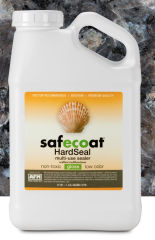 Anon/Oona:
Anon/Oona:
From the AFM Safecoat Technical Data Sheet we have:
- AFM SAFECOAT TECHNICAL DATA SPECIFICATIONS SHEET [PDF] - retrieved 2021/05/23 original source: http://www.afmsafecoat.com/products/stains-sealers/safecoat-hard-seal
Installation Guidelines
USE ON:
Previously uncoated or coated walls, ceilings woodwork,cabinetry, vinyl or porous tile.
and from the company's web page you give describing the product we have:
This multi-use, clear gloss sealer is formulated to provide mar resistance to both low- and high-porosity surfaces. It forms a continuous membrane when applied properly so it is particularly effective at sealing in any outgassing pollution or toxic chemical compounds.
Product description excerpt:
This multi-use, clear gloss sealer is formulated to provide mar resistance to both low- and high-porosity surfaces. It forms a continuous membrane and when applied properly in a multiple coat application is particularly effective at sealing in outgassing pollution or toxic chemical compounds.
Really? A possible reclama is "use on previously **un-coated** ..." If your ceiling tile surface has a plastic or other nonporous surface no paint-on product can be expected to adhere well.
What's to lose by trying a test area?
Our separate article
FLOORING ADHESIVE MASTIC SEALANTS
includes other products that are specifically formulated to bond to difficult- surfaces such as exposed mastic adhesive; some of those may work well on your ceiling if the AFM product doesn't bond successfully.
Those include
- Fiberlock SerpiFlex Asbestos Encapsulant [PDF]
Website except: SerpiFlex Asbestos Encapsulant is a concentrated water-based vinyl acrylic product with various flameretardant chemicals and fillers. It is nontoxic, non-combustible and does not contain any solvents or silicates. Available in clear, white and colors.
- Mapei PRIMER T [PDF] MAPEI Americas Headquarters 1144 E. Newport Center Drive Deerfield Beach, Florida 33442 USA, Technical Service: 1-800-992-6273 (U.S. and Puerto Rico) or 1-800-361-9309 (Canada). For help with locating a distributor of MAPEI products, call Customer Service at 1-800-426-2734 (1-800-42-MAPEI).
Website Excerpts: Use Primer T when applying a self-leveling underlayment on properly prepared suitable substrates.
Primer T is a low-VOC, magenta-colored, water-based acrylic primer that enhances the performance and adhesion of self-leveling underlayments (SLUs) on nonporous and porous substrates. Suitable for a wide variety of substrates, Primer T combines excellent versatility with easy, low-odor application. - PerfectPrimer, Specialty Solutions Manufacturing, Inc., 119 South 3d St New Hyde Park, NY 11040 USA Tel: 718 736 8477 Web: PerfectPrimer.com Email: info@perfectprimer.com
This sealant is marketed as safe for use over asbestos tiles, concrete, and mastics and is described by the company as an asbestos encapsulant.
Website excerpt: PerfectPrimer® is a complete floor prep system and universal primer/sealer. It forms a powerful molecular bond between nearly every coating or modified cement, with any clean, sound substrate including: wood, cut-back glue, sealed concrete, metal, roofing materials, ceramic tile, VCT, epoxies, masonry, and linoleum.
On 2020-09-06 - by (mod) - don't use an epoxy sealant on ceililng tiles
Apologies,
Certainly I'd not use an epoxy - thick, overkill, harder to apply, fumes and off-gassing questions, cost, difficulty of application might be some concerns.
I'll list some sealants appropriate for asbestos ceiling tiles - above.
On 2020-09-06 by Anonymous
Thanks for your quick response. I have looked at the pages you suggested and I cannot find reference to a specific sealant that would be appropriate for an acoustic tile ceiling. I do see this: "In residential applications if the flooring-( in this case ceiling - is in good condition you can gently clean, restore, and coat the flooring with an epoxy paint or with a clear restorative coating.
I see that Benjamin More has a water based epoxy paint (I need to limit the use of toxic chemicals in our home).
Would this suffice? In terms of a "clear restorative coating" do you mind looking at AMF Safe Coat Hardseal. www.afmsafecoat.com/products/stains-sealers/safecoat-hard-seal and seeing if this seems appropriate? I have some on hand and have used it successfully for other projects. Thanks so much!
On 2020-09-06 - by (mod) - seal asbestos-suspect ceiling surfaces to reduce risk
Oona
Your painting plan is fine, though perhaps over-kill; any paint or sealant that retards release of dust or fibres from the ceiling surface is fine.
At ASBESTOS FLOORING LEFT IN PLACE
we describe using paints and sealants on asbestos-containing flooring that include some that would work well on your ceiling too.
at DISINFECTANTS & SANITIZERS, SOURCES we list suppliers of sealants, some of which may be fine and simpler.
On 2020-09-06 by Oona McOuat - seal Canadian white hard foam-like 12" x 12" ceiling tiles that might contain asbestos
We have a small amount of white hard foam-like 12" x 12" ceiling tile in our bathroom. We are in Canada and the house was built in the 1970's with several renovations after that. I am presuming this tile contains asbestos. The tile is in great shape and we have no need to remove it or paint it, but I would like to seal and protect it from possible damage that might cause asbestos dust to enter our home.
I am thinking of using AMF Transitional Primer: https://eco-building.ca/product/afm-transitional-primer/ a coat of Benjamin Moore latex ceiling paint and then sealing the ceiling with AMF Safe Coat Hardseal. https://www.afmsafecoat.com/products/stains-sealers/safecoat-hard-seal
Does this sound like a good plan, or do you think that applying just the Hardocat sealer would be adequate given that the ceiling does not need to be painted?
On 2017-04-15 - by (mod) - Should a home inspector or A/C tech recognized a potentially asbestos containing ceiling tile?
I don't know, Andrew; I've seen rainbow textured ceiling coverings that may be like what you've found (use the page top or bottom CONTACT link to send us photos if you can) but don't have an authoritative asbestos/no-asbestos source by that pattern description.
A home inspector who sees acoustic ceiling tiles in a home built when asbestos-ceiling tiles were in common use in the 40s up to perhaps even the early 1980's might issue a caveat.
Certainly if ceiling tiles are visible from above (such as at a suspended ceiling) it may be possible to note manufacturer identification data that lets one determine just what ceiling product is installed.
And many ceiling tiles that are made of plant material or cellulose, excepting those that were cross-contamianted with asbestos, are usually not an asbestos procucct - but you can't normally see the edge or back of stapled-up or glued-up ceiling tiles, nor can you see their inteiror constituents.
In fine: because there were are are plenty of acoustic ceiling tiles made during that period that contain no asbestos, and as they look a lot alike, from just a visual inspection, especially of just the exposed or finished ceiling surface, a confident recognition of asbestos ceiling tiles seems unlikely.
See details at ASBESTOS CEILING TILE IDENTIFICATION
On 2017-04-15 by Andrew Orozco
Should a home inspector or A/C tech recognized a potentially asbestos containing ceiling tile?
Did ceiling tiles with rainbow shaped curves as a design going in various directions contain asbestos?
Reader Question: do you think these are asbestos-containing ceiling tiles and how can I take care of them?
Thanks for such a great and informative site. I’ve learned so much and I am still navigating the various sections.
[Click to enlarge any image]
It appears that you provide first-pass opinions on potential asbestos-bearing ceiling tiles if pictures are provided.
See attached. I cannot find anything similar to these that you’ve posted yet – and fingers-crossed – these are asbestos free.
Initial thoughts would be appreciated – I will get them tested too but your help may determine if I do this sooner versus later. Home was built in 1972. Thanks for any help.
- S.F., South Lyon MI 4/13/2013
Reply:
In our earlier correspondence I suggested treating the ceiling as presumed-asbestos-containing based on age and appearance; you were going to have a sample tested. Can you tell me what you found?
Reader Follow-Up:
I ended up changing my design to not disrupt the tile. I have painted it … actually, I am still painting it. LOL. I
did have a 30-year veteran electrician install one light. He was confident they were asbestos free and drilled one hole for a fixture. He wasn’t concerned at all.
At some point, years down the road .
If I change the ceiling …. I will have them tested. I have learned also, that all Building Materials in my Home Owner’s Association Ordinances required asbestos-free material.
That is no iron-clad insurance but gave me some confidence. Thanks for the follow-up
Reply:
I did the a similar thing with asphalt asbestos floor tiles in a kitchen - we painted the vinyl asbestos floor tiles with an epoxy floor paint, then applied a clear sealer over that; it has worked very well for 15+ years with just an occasional renewal of the clear coat.
Asbestos ceiling cover-up tip: an alternative for covering over a ceiling in poor condition for any reason is the installation of a metal ceiling or suspended metal ceiling - see METAL CEILINGS ALUMINUM & TIN. Metal ceilings have been installed over older, poor-condition surfaces in North America for more than 100 years.
A photo of your project might help others.
Reader Follow-Up:
Sure, DIY ers love to share their projects. Three photos attached (and shown above and at left - Ed).
#1 Before (thickness and type of tiles).
#2 Primed.
#3 After. Acoustic tiles are very, very porous.
It was like painting cardboard. I primed the edges around the mouldings first then I caulked the tile edges-to-the- mouldings liberally so I didn’t have holes/crevices along the moulding line.
Primed the interior ceiling with a 2” nappy roller (let dry for 2 days).
1 Coat of the new color (let dry for 2 days). Then … the hard part
I mixed vinyl spackling with paint and used a thick/cheap brush and jabbed the spackle/paint mixture into every seam (closing up gaps and any unevenness).
Let dry for 2 days. Final top coat to blend all seams with a 2” nappy roller.
Looks great. Folks can skip the seam fill part if they like the look after 1 coat of color; probably could skip the second coat of paint too.
Patching that hole wasn’t easy and I’m still working on that. Matching the ceiling pattern is hard but I’ll get it.
Watch out: dust from demolition of many building products can be irritating and even harmful regardless of whether or not the material contains asbestos fibers or particles. Good dust control measures can avoid spreading dust throughout the building during material removal or remodeling, and proper personal protection can protect workers as well.
Question: what should I do to reduce asbesos exposure risk from this ceiling?
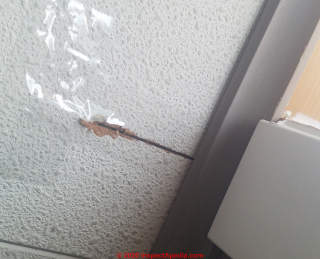 2020/01/18 Anonymous asked (by private email)
2020/01/18 Anonymous asked (by private email)
I have been reading the helpful articles on your website re: how tricky it is to figure out what may be contained in old ceiling tiles.
While I understand I would need professional testing to know for sure, I am really concerned about potential asbestos exposure in my bedroom.
The house was built in the 1920s or earlier but my particular room looks like it may have been renovated sometime in the 70s or 80s based on the style and wood paneling that was popular at that time. The ceiling tiles are about 12x12 inches and resemble a popcorn design.
Many years ago when a contractor was installing a window in my room he sawed through two of the tiles and they have been left exposed in my room ever since. It did not occur to me until today that possibly these ceiling tiles could contain asbestos.
The tiles themselves are hard (meaning I can't easily break through by touching or force) and the cross section of it is a dark brown material that everyone I have asked seems to think is some sort of wood or cellulose.
In your experience, could this small of damage to these tiles put me at risk of exposure if these tiles do indeed contain asbestos?
Or is the issue more immediately upon when the damage was done vs leeching out from this over a long period of time?
Any advice would help me feel better until I am able to have a professional help with this. Thank you for your time
Reply:
Thanks for the question and photos, anon.
Immediate action: As long as the ceiling tiles are not lilterally falling down, taping over areas of ceiling tile damage as you've done or even painting the ceiling can prevent even small amounts of fibre release from the ceiling as long as it's left un-disturbed.
Longer term, if you decide to treat the ceiling as "asbestos-containing" or "asbestos suspect" you can leave it in place and simply install drywall over it. That's the least-costly and most-recommended approach suggested by authorities such as the US EPA
Health risks from worry
From the tiny view I have it looks as if the ceiling may be a wood or cellulose product but as you say, to know you'd have to either find identifying markings that you can look-up or you'd have a sample tested.
The worry about a bit of dust from disturbing a couple of tiles years ago is itself likely to be a much more serious health risk than that prior work itself unless your contractor made an incredibly dusty mess.
Clean-up old dust:
Still if you think that dust remains, disposable damp-wipes of hard surfaces and for soft surfaces like carpets, HEPA-vacuuming is a reasonable clean-up step
Watch out: Don't fool with or try to vacuum the ceiling itself.
...
Continue reading at DO THESE CEILING TILES CONTAIN ASBESTOS? or see ASBESTOS TESTING LAB LIST for access to certified asbestos testing labs, or select a topic from the closely-related articles below, or see the complete ARTICLE INDEX.
Or see these
Recommended Articles
- ASBESTOS CEILING TILE IDENTIFICATION
- CEILING TILE HISTORY / DATES - asbestos ceiling tile history & Dates
- CEILING TILE MANUFACTURER ID
- ASBESTOS-FREE CEILING TILES
- CEILING TILE INGREDIENTS
- CEILING TILE REMOVAL PROCEDURES
- CEILINGS, DROP or SUSPENDED PANEL
- ASBESTOS CEILING TILE IDENTIFICATION - 5 Easy Steps to tell if CEILING TILES are likely to contain asbestos
- ASBESTOS CEILING TILE ID REQUESTS
- ASBESTOS CEILING TILE REMOVAL PROCEDURES
- ASBESTOS-FREE CEILING TILES
- ASBESTOS-SUSPECT CEILING COVEROVER
- ASBESTOS TESTING LAB LIST for access to certified asbestos testing labs
- DRYWALL INSTALLATION Best Practices
- DRYWALL INSTALLATION HORIZONTAL vs VERTICAL
Suggested citation for this web page
ASBESTOS-SUSPECT CEILING COVEROVER at InspectApedia.com - online encyclopedia of building & environmental inspection, testing, diagnosis, repair, & problem prevention advice.
Or see this
INDEX to RELATED ARTICLES: ARTICLE INDEX to ASBESTOS HAZARDS
Or use the SEARCH BOX found below to Ask a Question or Search InspectApedia
Ask a Question or Search InspectApedia
Try the search box just below, or if you prefer, post a question or comment in the Comments box below and we will respond promptly.
Search the InspectApedia website
Note: appearance of your Comment below may be delayed: if your comment contains an image, photograph, web link, or text that looks to the software as if it might be a web link, your posting will appear after it has been approved by a moderator. Apologies for the delay.
Only one image can be added per comment but you can post as many comments, and therefore images, as you like.
You will not receive a notification when a response to your question has been posted.
Please bookmark this page to make it easy for you to check back for our response.
IF above you see "Comment Form is loading comments..." then COMMENT BOX - countable.ca / bawkbox.com IS NOT WORKING.
In any case you are welcome to send an email directly to us at InspectApedia.com at editor@inspectApedia.com
We'll reply to you directly. Please help us help you by noting, in your email, the URL of the InspectApedia page where you wanted to comment.
Citations & References
In addition to any citations in the article above, a full list is available on request.
- 3/07: thanks to Gary Randolph, Ounce of Prevention Home Inspection, LLC Buffalo, NY, for attentive reading and editing suggestions. Mr. Randolph can be reached in Buffalo, NY, at (716) 636-3865 or email: gary@ouncehome.com
- 06/07: thanks for photographs of transite asbestos heating ducts, courtesy of Thomas Hauswirth, Managing Member of Beacon Fine Home Inspections, LLC and (in 2007) Vice President, Connecticut Association of Home Inspectors Ph. 860-526-3355 Fax 860-526-2942 beaconinspections@sbcglobal.net
- [1] Celotex 1973 Celotex Acoustical Systems catalog, January 1973
- [2] Celotex Home Building Materials, 1947 catalog, lists: Cane fiber products: Celotex sheathing, Celotex insulating lath (board), Celotex interior finish, Celo-Siding, Celo-Rok Gypsum products [may contain asbestos]: Celo-Rok anchor lath, Celo-Rock wallboards, Celo-Rok plasters, and Other Products: Celotex rock wool, Celotex roofing, Celotex hard boards, Celotex Cemesta, Celotex Corporation, Chicago IL
- [3] Celotex Insulating Cane Board, product catalog
- [4] Celotex Building Insulating Materials, 1948 Catalog, listing: Cemesto insulation, Cemesto roof decks, Cemesto exterior wall coverings, Cemesto interior wall coverings [we believe the Cemesto lines refer to cement-asbestos products - ed. ]
- [5] Celotex Sound Conditioning, 1948 Catalog, including perforated asbestos board sheets
- Celotex ceiling products division was purchased by Ceiling Products & Gypsum Wallboard (BPB) of the U.K. beginning in 1999
- Celotex roofing products division was purchased by Certainteed Corporation (Valley Forge PA) beginning in 1999
- [6] Certainteed Ceilings, Adagio fiberglass/mineral fiber composite acoustical ceiling product MSDS, web search 11/22/2011, original source: certainteed.com/resources/Adagio_MSDS_2010.pdf
- [7] "Board of Education for the School District of the City of Detroit v. Celotex, et al., Circuit Court of Wayne County, Michigan, No. 84-429634-ND"
- [8] Armstrong Corporation, web search 6/22/12, original source: http://www.armstrong.rs/commclgeu/eu1/uk/rs/FAQ_other.html, [Copy on file as Armstrong_Ceil_Asbestos.pdf]
- [9] Lipsitz & Ponterio, LLC, "Carpenters and Mesothelioma", Lipsitz & Ponterio, LLC, 135 Delaware Ave, 5th Floor, Buffalo, NY 14202-2415 (716) 849-0701. Web search 6/22/12, original source: http://www.mesotheliomacarpenter.com/carpenters-asbestos-exposure/ceiling-tile/ [Copy on file as LiIpsitz_Asbestos.pdf]
- [10] INACHI forum discussion about asbestos ceiling tiles, web search 6/22/12, original source: http://www.nachi.org/forum/f18/asbestos-ceiling-tiles-14709/ [Copy on file as Inach_Ceil_Asbestos.pdf]
- [11] Celotex [UK] History, Celotex Insulation Specialists, web search 6/30/12, original source: http://www.celotex.co.uk/celotex-history [Copy on file as Celotex_History_UK.pdf ]
- [12] Wikipedia Web: https://www.wikipedia.org/ provided background information about some topics discussed at this website provided this citation is also found in the same article along with a " retrieved on" date. NOTE: because Wikipedia entries are fluid and can be amended in real time, we cite the retrieval date of Wikipedia citations and we do not assert that the information found there is necessarily authoritative. Web search 6/30/12: "Ceiling Tiles"
- [13] Brian Greer, "History of Tin Ceilings", Brian Greer's Tin Ceilings, web search 6/30/12, original source: http://www.tinceiling.com/company/historytin.php
- [14] Armstrong Corporation, "Corporate History: a Historical Summary", web search 6/30/12, original source: https://www.armstrongflooring.com/corporate/corporate-history.html
- [15] "Ceilings Pressed in Time", Old House Journal, web search 6/30/12, original source: http://www.oldhousejournal.com/ceillings_pressed_in_time/magazine/1070
- [16] Steven Mlynarek, Morton Corn, Charles Blake, "Asbestos Exposure of Building Maintenance Personnel", Regulatory Toxicology and Pharmacology, 23, 213–224 (1996) ARTICLE NO. 0045, http://library.certh.gr/libfiles/PDF/GEN-PAPYR-4810-ASBESTOS-by-MLYNAREK
-in-RTAP-VOL-23-ISS-3-PP-213-224-Y-1996.pdf - [17] National Institute of Occupational Safety and Health (NIOSH) (1989). In NIOSH Manual of Analytical Methods (P. M. Eller, Ed.), Method 7400. NIOSH, Washington, DC.
- [18] U.S. Environmental Protection Agency (USEPA—Green Book) (1990). In Managing Asbestos in Place: A Building Owners Guide to Operations and Maintenance Programs for Asbestos-Containing
- [19] U.S. Department of Labor, Occupational Safety and Health Administration (USDOL) (1994). In Occupational Exposure to Asbestos: Final Rule, FR Vol. 59, No. 153:40964–41162. Materials, Report 2OT-2003. USEPA, Washington, DC.
- [20] U.S. Department of Labor, Occupational Safety and Health Administration
(USDOL) (1986). In Occupational Exposure to Asbestos: Tremolite, Anthophyllite, and Actinolite: Final Rule, FR Vol. 51, No. 119:22631–22644. - [21] U.S. Environmental Protection Agency (USEPA) (1990). In Environmental Asbestos Assessment Manual, Superfund Method for the Determination of Asbestos in Ambient Air, Part 2, Technical Background Document, Report EPA/540/2-90/005 b. USEPA, Washington, DC
- [22] Ceiling - Frequently Asked Questions, Armstrong Corporation, web search 6/30/12, original source: https://www.armstrongflooring.com/resclgam/na/ceilings/en/us/article17697.html
- [23] BPB America Inc., 5301 West Cypress St., Suite 300, Tampa, FL 33607, Tel: 866-427-2872 E-mail: crc@bpb-na.com Web: www.bpb-na.com. Acoustic ceiling tile & accessories.
- [24] Affa Tile Company No. 1116/8, Poonamalee High Road, Opposite Hotel Shan Royal, Koyambedu Chennai, Tamil Nadu - 600 107, India, E-Mail: affatiles@gmail.com website: http://www.affatiles.com Tel:044-24757498, 044 - 24757497
- [25] Made-in-China.com, online sevice to connect buyers with product suppliers in China, web search 6/30/12
- [26] "Directive 2003/18/EC of the European Parliament and of the Council of 27 March 2003 amending Council Directive 83/477/EEC on the protection of workers from the risks related to exposure to asbestos at work". Publications Office of the European Union. 27 March 2003 Web search 6/30/12, original source: http://eur-lex.europa.eu/LexUriServ/LexUriServ.do?uri=CELEX:32003L0018:EN:NOT,
- [27] H. M. Murray, testimony before the Departmental Committee on Compensation for Industrial Diseases "Minutes of Evidence, Appendices and Index", 1907. p. 127
- [28] D. Auribault, "Note sur l'Hygiène et la Sécurité des Ouvriers dans les Filatures et Tissages d'Amianté (On hygiene and security of the workers in the spinning and weaving of asbestos)" in Le Bulletin de l'Inspection du Travail, 1906, pp 120–132.
- [29] Wikipedia entry on Asbestos and various citations from that article, web search 6/30/12, original source: en.wikipedia.org "Asbestos"
- Asbestos Identification and Testing References
- Asbestos Identification, Walter C.McCrone, McCrone Research Institute, Chicago, IL.1987 ISBN 0-904962-11-3. Dr. McCrone literally "wrote the book" on asbestos identification procedures which formed the basis for current work by asbestos identification laboratories.
- Stanton, .F., et al., National Bureau of Standards Special Publication 506: 143-151
- Pott, F., Staub-Reinhalf Luft 38, 486-490 (1978) cited by McCrone
- Asbestos NESHAP ADEQUATELY WET ASBESTOS GUIDANCE, EPA340/1-90-019, December 1990, U.S. ENVIRONMENTAL PROTECTION AGENCY, Office of Air Quality Planning and Standards, Stationary Source Compliance Division, Washington, DC 20460,original web source: http://www.epa.gov/region04/air/asbestos/awet.htm
- Asbestos products and their history and use in various building materials such as asphalt and vinyl flooring includes discussion which draws on ASBESTOS, ITS INDUSTRIAL APPLICATIONS, ROSATO 1959, D.V. Rosato, engineering consultant, Newton, MA, Reinhold Publishing, 1959 Library of Congress Catalog Card No.: 59-12535 (out of print, text and images available at InspectAPedia.com).
- EPA ASBESTOS MATERIALS BAN: CLARIFICATION 1999
- "Handling Asbestos-Containing roofing material - an update", Carl Good, NRCA Associate Executive Director, Professional Roofing, February 1992, p. 38-43
- EPA Guidance for Controlling Asbestos-Containing Materials in buildings, NIAST, National Institute on Abatement Sciences & Technology, [republishing EPA public documents] 1985 ed., Exposure Evaluation Division, Office of Toxic Substances, Office of Pesticides and Toxic Substances, U.S. Environmental Protection Agency, Washington,D.C. 20460
- In addition to citations & references found in this article, see the research citations given at the end of the related articles found at our suggested
CONTINUE READING or RECOMMENDED ARTICLES.
- Carson, Dunlop & Associates Ltd., 120 Carlton Street Suite 407, Toronto ON M5A 4K2. Tel: (416) 964-9415 1-800-268-7070 Email: info@carsondunlop.com. Alan Carson is a past president of ASHI, the American Society of Home Inspectors.
Thanks to Alan Carson and Bob Dunlop, for permission for InspectAPedia to use text excerpts from The HOME REFERENCE BOOK - the Encyclopedia of Homes and to use illustrations from The ILLUSTRATED HOME .
Carson Dunlop Associates provides extensive home inspection education and report writing material. In gratitude we provide links to tsome Carson Dunlop Associates products and services.


